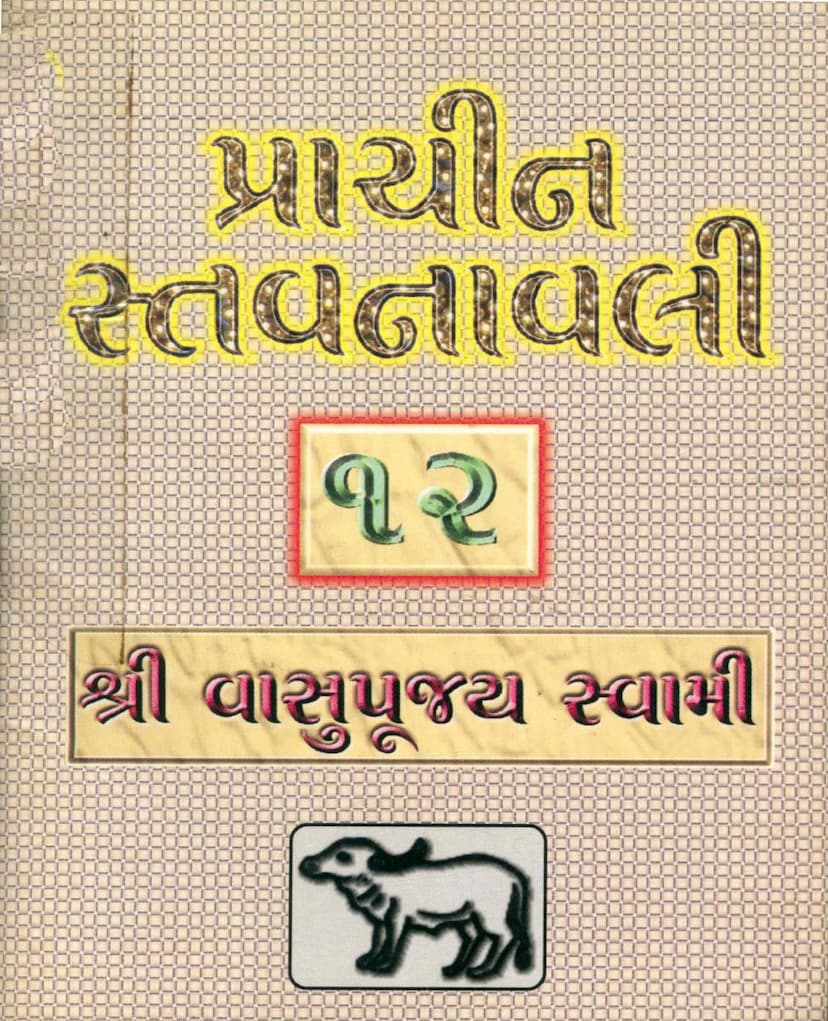Prachin Stavanavli 12 Vasupujya Swami
Added to library: September 2, 2025

Summary
This document is a collection of devotional songs (Stavans) and prayers dedicated to Vasupujya Swami, the 12th Tirthankara in Jainism. Titled "Prachin Stavanavali 12 Vasupujya Swami," it is authored by Hasmukhbhai Chudgar and published by the same.
Here's a comprehensive summary of the content:
Overall Theme: The book is a devotional compilation focused on Vasupujya Swami, offering prayers, hymns, and liturgical texts to be recited and sung by devotees. The central purpose is to express devotion, seek spiritual guidance, and reflect on the virtues and life of Vasupujya Swami.
Key Sections and Content:
- Title and Author Information: Clearly states the title, author, and publisher, indicating it's a collection of ancient devotional songs.
- Namokar Mahamantra Mahima (Page 2): The first substantial piece is a hymn glorifying the Namokar Mahamantra, highlighting its essence, auspiciousness in all situations, and its ability to bestow blessings and remove suffering.
- Index (Page 5-8): A detailed index lists numerous Stavans (devotional songs) dedicated to Vasupujya Swami, along with their authors. This section reveals the breadth of the collection, featuring contributions from many prominent Jain scholars and saints. The page numbers for each Stavan are provided.
- Chaitra Vandan Vidhi (Pages 9-15): This section outlines the Jain ritual of Chaitra Vandan (worship of Chaityas, which are temples or idols). It details the specific Sutras (verses) to be recited during this ritual, including:
- Ichchhami Khamasamanam Sutra: A formal request for forgiveness.
- Irriyavahiyam Sutra: A prayer to atone for any harm caused to living beings while moving.
- Tass Uttari Sutra: A prayer for further purification of sins.
- Annatth Sutra: Describing the sixteen agars (virtues or rules) for Kaussagga (meditation).
- Logassa Sutra: A hymn of praise to all 24 Tirthankaras.
- Jinkinchi Sutra: A prayer to all Jinabimbas (idols) in the three worlds.
- Namutthune Sutra: A detailed praise of the qualities of the Arhats.
- Javantik Cheiaï Sutra: A prayer to all Jin temples.
- Javant Kevhi Sahu Sutra: A prayer to all ascetics in the three regions.
- Namo Arihantanam Sutra: A salutation to the Pancha Parameṣṭhi (five supreme beings).
- Jaya Viyaraya Sutra: A prayer for protection and liberation.
- Arihant Cheiïanam Sutra: A prayer for the idols in the Chaityas.
- The text also explains the bhavarth (meaning) of each sutra and provides instructions for recitation, including when men and women should perform specific actions.
- Stavans (Pages 15-57): The bulk of the book is dedicated to the Stavans. Each Stavan is attributed to a specific author and often includes the raag (melody or tune) in which it should be sung. These Stavans praise various aspects of Vasupujya Swami's life, virtues, and divine presence:
- Life and Attributes: Descriptions of his birth, parents (King Vasupujya and Queen Jaya), birthplace (Champapuri), complexion (red or coral-like), lifespan (7.2 million years), height (70 dhanush), auspicious marks (lanchhana - bull), and divine powers.
- Devotional Expressions: The Stavans express deep love, longing, and surrender to Vasupujya Swami. They describe him as the beloved, the remover of sorrow, the fulfiller of desires, and the ultimate guide to salvation.
- Metaphors and Imagery: The poets use rich metaphors and imagery, comparing Vasupujya Swami to the sun (dispelling darkness), a wish-fulfilling tree, the ocean of compassion, and many other celestial and earthly phenomena to convey his greatness.
- Call to Devotion: Many Stavans encourage devotion through sincere love, remembrance, and meditation, promising spiritual and material benefits.
- Vasupujya Swami's Life Glimpse (Page 68): A brief biographical outline of Vasupujya Swami is provided, summarizing key details like his birthplace, parents, complexion, lifespan, height, and significant life events like his diksha (renunciation) and kevalgyan (omniscience).
- Concluding Message: The concluding message from Acharya Shri Bhuvanbhanusurishwarji Maharaj emphasizes the importance of gratitude towards the Tirthankaras, the supreme value of devotion to the Arhats, and the meditative union with the Parmatma (supreme soul) as a great yoga. It also encourages prioritizing the Jain dharma for future lives.
Significance:
This book serves as a valuable resource for Jain devotional practices, particularly for followers of Vasupujya Swami. It preserves ancient hymns and rituals, allowing devotees to connect with the spiritual heritage of Jainism. The collection reflects the rich tradition of devotional poetry within Jainism and the deep reverence held for Tirthankaras.